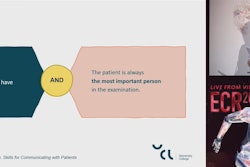Music can be calming for patients undergoing medical imaging, an article published February 7 in Radiography suggests.
A team led by Lina Vieira, PhD, from the Lisbon Polytechnic Institute in Portugal found that musical interventions, whether they be classical songs or sounds of nature, can reduce anxiety and heart rate outcomes in patients. This includes imaging procedures such as MRI, mammography, and PET among others.
“Musical intervention arises as a painless, reliable, low-cost, and side-effect-free strategy, presenting imaging departments with a practical means to enhance patient comfort and mitigate anxiety and stress during medical procedures,” the Vieira team wrote.
While medical imaging has proven its value in health screening, such procedures can be anxiety-inducing and uncomfortable for patients. This includes patients experiencing claustrophobia in MRI machines, compression pain from mammography, or concerns about radiation exposure.
Previous research has explored ways to comfort patients during imaging procedures, one being musical intervention. Here, technologists can create music playlists to help ease patients’ minds before and during procedures. In some cases, the patients themselves can select songs to be played.
Vieira and colleagues explored the impact of such interventions on psychophysiological outcomes during imaging procedures. This includes focusing on the sound repertoire and technical characteristics employed in musical interventions.
The researchers included 13 studies in their analysis. Of these, four were included to perform a meta-analysis on anxiety and heart rate outcomes. Also, most studies used digital playlists, and headphones were commonly used. Finally, the team noted that music was played at an average volume of 50 to 60 decibels and a frequency of 60 to 80 beats per minute, meaning slower songs were used. Two studies used Johann Pachelbel's "Canon in D major” as their musical theme.
Meanwhile, the imaging modalities and procedures took place in these studies: MRI, coronary angiography, vascular angiography, PET, myocardial perfusion scintigraphy, mammography, and cerebral angiography.
The researchers reported that four studies demonstrated significant responses to musical interventions when it came to improving the exam experience and patient comfort. Two other studies showed that music significantly reduced stress in patients, and nine of the total studies indicated significantly decreased anxiety levels among patients.
On meta-analysis (four studies), the team found no statistically significant differences in average preprocedure anxiety levels between control and musical intervention groups. However, the musical intervention group did experience lower heart rates in these studies. Additionally, postprocedure anxiety levels and heart rate decreased among patients in the intervention group on meta-analysis.
Finally, the researchers reported no significant results regarding blood pressure and breaths per minute.
The study authors highlighted that while it “was not possible” to find the most influential musical intervention in terms of genre or natural sounds, it “seems clear” that slower, softer, and relaxing music is appropriate in this area.
The full analysis can be found here.



















